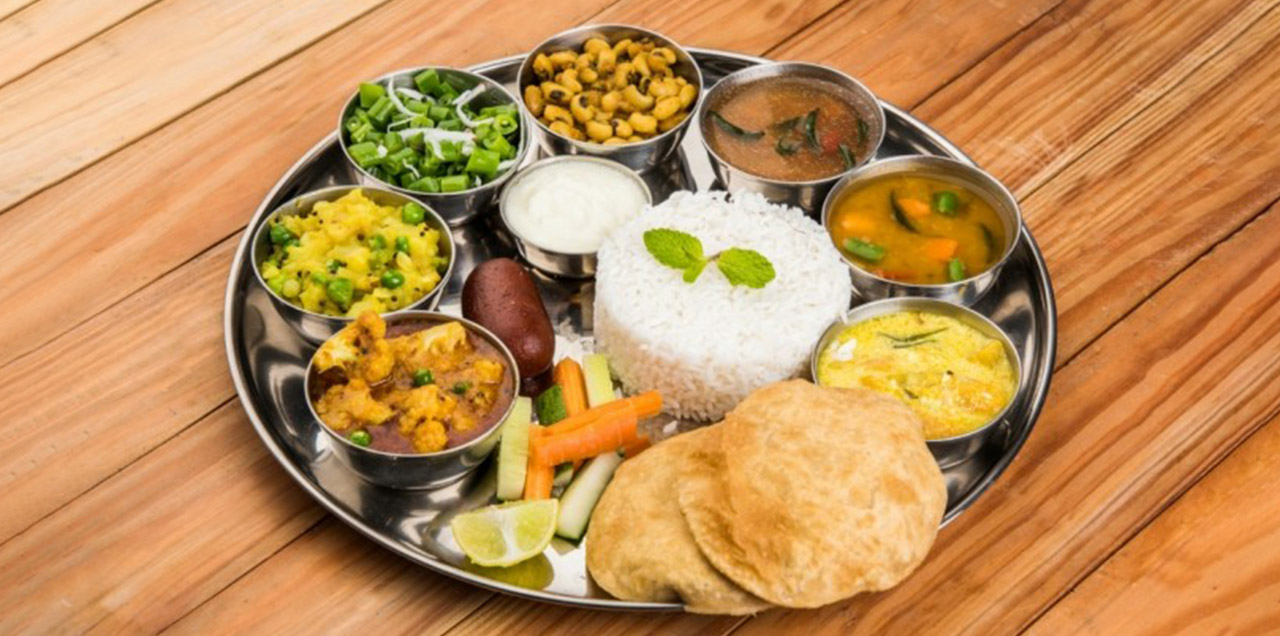You and I can surely vouch that the flavors of Indian cuisine are so vibrant that they can truly delight the taste buds and provide deep satisfaction. Many people mistake vibrant spices for being overly spicy, but Indian cuisine is expertly balanced, offering just the right combination of flavors. It's not just about taste, though – traditional Indian cuisine also provides a well-rounded nutritional perspective in every meal. Every meal is considered complete, and the idea of a "balanced thali" exemplifies the culinary mastery that encompasses flavor, nutrition, and tradition. Each element of the thali contributes to a symphony that excites the palate and nourishes the body and soul.
So, what does a balanced thali look like?
The Anatomy of a Balanced Thali
A thali is more than just a meal; it is an experience. Traditionally served on a large plate with multiple smaller bowls, a thali includes a variety of dishes that cover all the essential food groups. A complete thali includes;
- Grains: Roti (flatbread) and rice are staple grains in a thali, providing essential carbohydrates for energy.
- Pulses: Lentils or dals are rich in protein and fiber, making them a vital part of the meal.
- Vegetables: A mix of seasonal vegetables adds vitamins, minerals, and antioxidants to the thali.
- Proteins: Depending on regional preferences, this could include paneer (cottage cheese), yogurt, or meat.
- Condiments: Pickles, chutneys, and yogurt-based raitas add flavor and aid digestion.
- Sweets: A small portion of dessert provides a satisfying end to the meal.
- Papad and Salad: These add a crunchy texture and freshness, balancing the meal.
Nutritional Harmony
The genius of the balanced thali lies in its ability to offer a complete nutritional profile in one meal. Each element plays a role in ensuring that the body receives the necessary nutrients:
- Carbohydrates: Grains like rice and roti provide sustained energy.
- Proteins: Dals and curd offer essential amino acids, crucial for muscle repair and growth.
- Vitamins and Minerals: Vegetables and salads supply a wide range of vitamins (A, C, K) and minerals (iron, potassium).
- Probiotics: Yogurt helps maintain gut health with beneficial bacteria.
- Fiber: Pulses and vegetables aid in digestion and keep you full longer.
Diverse Thalis of A Diverse Country
India’s diverse culinary landscape means that the concept of a balanced thali varies from region to region, each bringing its unique ingredients and flavors to the table.
- North Indian Thali: Typically includes roti, rice, dal, a vegetable curry, yogurt, and a sweet like gulab jamun.
- South Indian Thali: Features rice, sambar (a lentil-based stew), rasam (a tangy soup), a variety of vegetable curries, and a dessert like payasam.
- Gujarati Thali: Known for its variety and balance of sweet and savory dishes, it includes roti, dal, kadhi (a yogurt-based curry), rice, and a sweet dish like shrikhand.
- Rajasthani Thali: Often includes bajra roti (millet bread), dal baati churma (lentils with wheat balls and a sweet dish), and a variety of pickles and chutneys.
The Thali and Wellness
In recent years, the balanced thali has gained attention not just for its culinary richness but also for its health benefits. Nutritionists and wellness experts advocate for the thali as a model for balanced eating. Here’s why:
- Portion Control: The thali inherently promotes portion control. The small bowls ensure that no single food group is overrepresented, preventing overeating.
- Variety and Balance: With a mix of grains, proteins, and vegetables, the thali exemplifies dietary diversity, which is crucial for getting a range of nutrients.
- Mindful Eating: The thali encourages mindfulness. Eating a variety of small portions slowly allows the body to signal fullness, reducing the likelihood of overconsumption.
- Sustainability: Using seasonal, locally sourced ingredients in a thali not only supports local agriculture but also ensures that the food is fresh and nutrient-dense.
Embracing the Thali in Modern Life
In today’s fast-paced world, where convenience often trumps nutrition, the balanced thali offers a refreshing return to mindful, nutritious eating. For those looking to adopt a healthier lifestyle, incorporating elements of the thali into daily meals can be a step in the right direction.
Restaurants and home kitchens alike can embrace the thali concept, creating meals that are not only delicious but also nourishing. By celebrating the balanced thali, we honor a tradition that has sustained generations and continues to be a beacon of holistic health and culinary delight.
The balanced thali is more than a meal; it is a celebration of India’s rich culinary heritage and a testament to the wisdom of balanced eating. As we savor each bite, we partake in a tradition that nurtures the body, pleases the palate, and connects us to our roots. In the harmonious notes of the thali, we find not just nourishment, but a way of life.
Want to learn more about maintaining a healthy lifestyle? Visit Hello Fitness Magazine for expert tips, advice, and articles on all things health and fitness.














